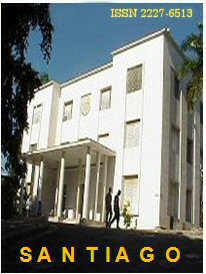A glance to Chalguayacu´s vernacular housing
Keywords:
vernacular housing, afroecuatorians, tipology, safeguard's politics.Abstract
The community of Chalguayacu, Valley of the Chota, Ibarra, Ecuador, conserves a score of properties that are erected as example of an architecture type conceived starting from the use of local materials as the adobe, the stone, the wood and the mud for a population's afro ecuatorians room dedicated to the agriculture. For the conception of this work we do leave of the following question: which the distinctive characteristics of the vernacular housing of Chalguayacu are? This village from its emergence was tributary of this tipology but it experienced an evolution associated to an economic situation that also suffered changes. It is houses of rectangular plant and simple facade with covered to four waters and cement floors, located to the long of the streets, result of the fork of the indigenous element with the african-american one and some hispanic contribution. Today they are in danger of disappearing given the non existence of safeguard's politics.References
Aguilar, B. (2001). Estado del arte sobre la arquitectura vernácula en México. En Vivienda rural. Tercer Seminario sobre vivienda rural y calidad de vida en los asentamientos rurales. Memoria. CYTED- HABITED- RED XIV-E. (pp. 809-818). Santiago de Cuba.
Arrata, M. (2014). Destrucción de la arquitectura vernácula campesina en los andes ecuatorianos. Agusvinnus, 9. ISSN 2362-6526.
Cabrera, M. (2007). La arquitectura doméstica de madera en Santiago de Cuba. (Trabajo de grado, Doctorado en Ciencias Técnicas). Universidad de Oriente, Cuba.
Cárdenas, E. (1998). Problemas de teoría de la Arquitectura. México: Universidad de Guanajuato, Editorial Universitaria.
Chalá, J. (2006): Chota profundo. Antropología de los afrochoteños. Abya-Yala, Quito.
Coronel, R. (1991). El valle sangriento: de los indígenas de la coca y el algodón a la hacienda cañera jesuita, 1580-1700. (Vol. 4). Editorial Abya Yala.
García, A. (2005, enero-abril). Vivienda, familia, identidad. La casa como prolongación de las relaciones humanas. Trayectorias, VII (17), 43-56 Universidad Autónoma de Nuevo León, Monterrey, Nuevo León, México.
Instituto Nacional de Patrimonio Cultural (2010). Inventario de las viviendas vernáculas de Chalguayacu, Ecuador.
Martínez, L. (1954). Monografía de la parroquia de Pimampiro. Imbabura, Ecuador: Imprenta Municipal de Ibarra.
Oliver, P. (1997). Encyclopedia of Vernacular Architecture of the World. (Vol. III. Cultures and Inhabitants). United Kingdom: Cambridge University Press.
Rapoport, A. (1969). Vivienda y cultura. Barcelona: Gustavo Gili.
Rudofsky, B. (1973). Arquitecturas sin Arquitectos. Argentina: Editorial Universitaria de Buenos Aires.
Saravino, M. (2011). Arquitectura indígena: fundamentos para la generación de una arquitectura contemporánea. Recuperado de http://repositorio.usfq.edu.ec/bitstream/23000/825/2/99846%20(Tesis).pdf
Soto, M. (2006). La vivienda del movimiento moderno en Santiago de Cuba. (Trabajo de grado, Doctorado en Ciencias Técnicas). Universidad de Oriente, Cuba.
Tillería, J. (2010). La arquitectura sin arquitectos, algunas reflexiones sobre arquitectura vernácula. Revista AUS (8), pp.12 -15.
Vera, M. (1953). Los negros en el sur de Colombia. Revista de Educación, 16, p.45.
Yépez, D. (2012). Análisis de la arquitectura vernácula del Ecuador: propuestas de una arquitectura contemporánea sustentable. Universidad Politécnica de Cataluña.
Downloads
Published
Issue
Section
License
Copyright (c) 2017 Miguel Edmundo Naranjo-Toro, Diana María Cruz-Hernández

This work is licensed under a Creative Commons Attribution-NonCommercial-NoDerivatives 4.0 International License.
CC Reconocimiento-NoComercial-SinObrasDerivadas 4.0



.jpg)

_de_logo.jpg)













